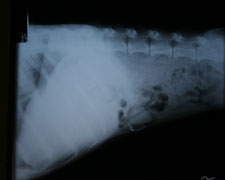Rescued animals get needed medical care
April 3rd, 2011
Submitted by EARS volunteer Beth Gammie of Phoenix, Arizona
 |
| The rescued animals are being well fed. |
The 228 animals rescued from a hoarding situation in Apache County, Arizona arrived at UAN’s emergency shelter on March 23 and 24 in varying conditions: emaciated, undernourished, injured, timid, terrified, shut-down and lethargic. Veterinarians examined each animal and assessed their medical condition so they could receive appropriate care at the shelter, or be transported to a veterinary clinic. The animals suffered from conditions one would expect in animals living with minimal or non-existent care: malnourishment, dehydration, worms, untreated injuries (including bone fractures), mange and dental problems. With sound nutrition, water, shelter, and TLC from UAN’s Emergency Animal Rescue Service (EARS) volunteers, the turnaround in many of their conditions is amazing.
However, the sad reality for hoarded animals is that they often suffer serious medical problems that aren’t so easily diagnosed and treated. UAN and its partnering agency, The Humane Society of the United States (HSUS), are determined that the rescued animals under their care receive the medical care they need.
 |
| Chester gets IV fluids at the vet clinic. |
Chester is a case in point. This gray-bearded older gentleman quickly became a volunteer favorite at the shelter. His emaciated condition and lethargy appeared to be caused by malnutrition; his behavioral “shut down” seemed to result from the hoarding conditions under which he lived. Over the first week, Chester ate and drank. He hunkered down in the blanketed half-crate in his kennel, and seemed comforted by his kennel mate, Buster. However, Chester did not display the turnaround seen in other dogs. Two days ago, when we saw Chester vomiting, we transported him to the Alta Sierra Veterinary Hospital in Show Low for treatment. Dr. Steve Andersen ran bloodwork and put Chester on IV fluids. Friday Dr. Andersen said, “There’s no diagnosis yet.” Dr. Andersen and his team will continue to care for Chester, take X-rays and perform other diagnostic tests to find out what ails him.
 |
| X-rays revealed one dog has a wire lodged in his torso. |
For another emaciated dog being treated at Alta Sierra, X-rays revealed the cause of his problems. What appears to be a wire is lodged inside the torso of this poor guy. The staff at Alta Sierra continue to provide loving care to him, and make him as comfortable as possible as treatment options are assessed.
In Daisy the pig’s case, the vet made a house call. At approximately 650 pounds, driving Miss Daisy requires a trailer. Dr. Milton DeSpain from the Cedar Ridge Veterinary Center came to the shelter and examined Daisy. EARS staff and volunteers noticed how overgrown Daisy’s hooves are. During the rescue, HSUS staff noticed how painfully Daisy walked. We expected Dr. DeSpain to trim her hooves yesterday; however, he found Daisy so emaciated (she is only about half her healthy weight) he feared the sedation required for her hoof trimming might kill her. The best course of treatment is to continue building up her weight until it is safe to care for her hooves. We are also mixing her water with pedialyte and Gatorade on the vet’s instruction because she is so dehydrated.
While we tend to focus more on the amazing recovery that many of the rescued animals make, EARS volunteers and staff alike bravely face hoarding’s most tragic cases.



